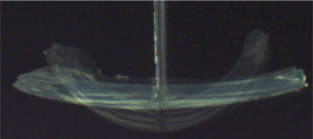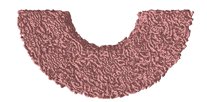Gels and hydrogelsare characterized by highy versatile materials propterties that make them particularly interesting for application in the field of life sciences. Energetic electrons offer the possibility for modification of hydrogels of biological origin, functionalization as well as synthesis of hybrid systems (nanoparticle-gel composites, ferrogels, synthetic-biological systems), resulting in novel properties. These include bioactivity, stimuli responsiveness, shape memory behavior or switching behavior.
Expertise
- Biomimetic electron beam modified collagenous (hydro-)gels and networks, biomineralization
- Intelligent, switchable and stimuli-responsive hydrogels, shape memory hydrogels – electron beam modified bioderived gels.
- Electron beam synthesized hybrid systems (nanoparticle-gel composites, ferrogels, hydrogel coatings, synthetic-biological systems)
- Applied experimental research, modeling and transfer to application
Highlights
Reagent-free programming of shape-memory behavior in gelatin by electron beams: Experiments and modeling
S. Riedel, S. G. Mayr
Phys. Rev. Appl. 9 (2018) 024011
https://doi.org/10.1103/PhysRevApplied.9.024011Electron beam modified gelatin reveals programmable shape memory behavior, that is based on an interplay between electron beam introduced covalent crosslinks and triple helices that open and close thermally.
Reagent-free mechanical patterning of gelatin surfaces by two-step electron irradiation treatment
S. Riedel, K. Bela, E. I. Wisotzki, C. Suckfüll, J. Zajadacz, S. G. Mayr
Materials & Design 153, 80 (2018)
https://doi.org/10.1016/j.matdes.2018.04.076Application of a focused electron beam locally allows for mechanical patterning of hydrogel surfaces.
Design of biomimetic collagen matrices by reagent-free electron beam induced crosslinking: Structure-property relationships and cellular response
S. Riedel, P. Hietschold, K. Krömmelbein, T. Kunschmann, R. Konieczny, W. Knolle, C. Mierke, M. Zink, S. G. Mayr
Materials & Design 168 (2019) 107606
https://doi.org/10.1016/j.matdes.2019.107606Electron irradiation allows for crosslinking of collagen matrices, leading to highly tunable network topologies and mechanical properties. These findings are the basis for advanced collagen scaffolds for biomedical applications.
Contact Guidance by Microstructured Gelatin Hydrogels for Prospective Tissue Engineering Applications
M. Tadsen, R. P. Friedrich, S. Riedel, C. Alexiou, S.G. Mayr
Appl. Mat. & Interf. 11 (2019) 7450
https://doi.org/10.1021/acsami.8b21638Electron beam assisted imprinting allows to transfer a large variety of surface patterns into hydrogel surfaces. These template hydrogels are then highly suitable for tissue engineering applications due to their bioactivity.
Impact of high-energy electron irradiation on mechanical, structural and chemical properties of agarose hydrogels
C. Krömmelbein, M. Mütze, R. Konieczny, N. Schönherr, J. Griebel, W. Gerdes, S. G. Mayr, S. Riedel
Carbohydrate Polymers 263 (2021) 117970
https://doi.org/10.1016/j.carbpol.2021.117970The impact of energetic electron irradiation on the structural, mechanical and chemical properties of agarose is explored in detail as function of dose.



